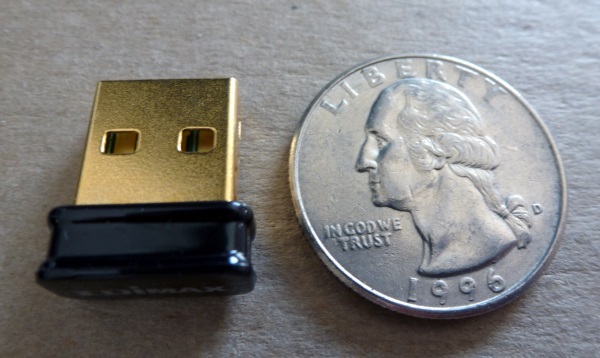USB Wi-Fi Adapter 101
External Versus Internal Antenna
USB Wi-Fi adapters can be categorized based on their antennas, which can be omnidirectional (transmitting and receiving in all directions) or directional (focusing the transmission in only one direction). The strength of an antenna gets expressed in decibels (dB) relative to a standard reference antenna. Because this standard reference antenna is isotropic, that metric gets expressed as dBi, meaning decibels relative to the isotropic antenna. While this spec is not consistently available for USB Wi-Fi adapters, in cases when it is, this allows a more direct comparison of the expected signal strength for the adapter.
One differentiating factor of USB adapters is an external antenna, or a slimmer profile with an internal antenna. Both have their advantages, disadvantages and applications.
In situations where the signal strength is less than optimal, whether due to router location, interfering obstacles like walls and/or floors, and when there are multiple Wi-Fi networks nearby, a USB-based Wi-Fi adapter with an external antenna is preferred. Also, in the situation where a 5GHz signal is chosen for the Wi-Fi connection, but it is not strong, an adapter with an external antenna can make it usable (keeping in mind that 5GHz penetrates obstacles like walls or floors less than 2.4GHz). An adapter with an external antenna that can be adjusted and positioned to optimize signal strength is particularly ideal for these situations.
While an adapter with an external antenna is ideal from the standpoint of signal strength, they also tend to be bulky and protrude from the USB port. While less of an issue with a desktop, this can be a particular problem in a notebook, especially when they can get hit, and the USB port potentially damaged. In situations where the signal strength is strong, a smaller USB Wi-Fi adapter with an internal antenna and slim profile becomes the preferred choice.
In the never-ending quest for tiny electronics, a class of USB Wi-Fi adapters has emerged that can be described as “nano,” with the adapter only slightly larger than the USB port itself. While devices like this can certainly offer performance in a smaller package, keep in mind that a strong signal from a router is necessary for such a device to maintain a fast connection.
Get Tom's Hardware's best news and in-depth reviews, straight to your inbox.
Current page: External Versus Internal Antenna
Prev Page Anatomy Of A USB Wi-Fi Adapter Next Page Software
Jonas P. DeMuro is a freelance reviewer covering wireless networking hardware.
-
Achoo22 Replya computer needs to be connected to its network, and in turn the Internet, to be truly useful
I got this far, then tuned out. -
SuperVeloce Reply
okay, I see you don't get what the intended audience in this article is. i'll re-word that for you: "a multimedia family / office work computer needs to be connected to its network..."a computer needs to be connected to its network, and in turn the Internet, to be truly useful
I got this far, then tuned out. -
SamSerious USB extension cables are often causing problems. I'd never extend a cable by more than one meter and make sure it is a very high quality cable or the voltage will lower dramatically causing the device not to work properly anymore. Or you have to get yourself an active USB expander which is usually quite a bit more expensiv.Reply
On the other hand, antenna cables are even worse to extend... -
jacobian You think you need USB3 to drive a 802.11ac network adapter at full speed? Please. You couldn't have been more confused. Let's say we're talking about a two stream AC device, so theoretically it's capable of 867mbps throughput in 5GHz band. However, much of that number pertains to the "physical layer" information transfer, the chatter that ensures that your data is transferred accurately, under optimal condition (e.g. 6 ft from the router). At TCP/IP level, the throughput will be much lower, even if the distance is short, somewhere in the neighborhood of 100-300mbps, depending on your luck. In other words, a lot less than USB2 can handle.Reply
You see, the wireless data transfer rates are basically a big marketing scam because half of more of that data transfer rate will disappear due to weakening signal with distance or on the physical layer chatter. Wireless is not like wired Ethernet, where saying 100Mbps really means that you will actually see TCP/IP data transferred nearly at that rate. In the wi-fi world, the marketing can say they sell you a "gigabit ac1750 router (or adapter)", and in real life you may well end up with just 100Mbps or slower data throughput. If you get 200mbps or more, you should be jumping from joy. -
ZeusGamer I'm using a dual band PCI Express wi-fi module. For some reason, it's much better than my ethernet connection. Could be because my killer port is only single band rather than dual. I've not lagged one bit with this accessory and I've been using it for at least 8 - 9 months now.Reply -
user_friendly Id like to point out that having an external usb wifi can get really hot and malfunction. Its not inside of an air circulated case, so mine tends to get blazingly hot. i have the n600 which i can game on and have no problems. MosltyReply
